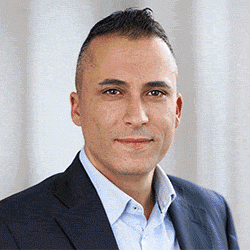"The retrofit is not just about better lighting technology, but also about making public lighting smarter"
On the road in the "land of DigiStreet luminaires" - in Glarnerland
The tb.glarus (Technische Betriebe Glarus) operate the public lighting (ÖB) on behalf of the municipality of Glarus. The certified energy town strives for a sustainable, coordinated and efficient energy supply - this also includes the adaptation of the ÖB to LED. But that's not all, as Martin Zopfi-Glarner (Managing Director tb.glarus) tells us: "The conversion is not just about better lighting technology, but also about making the public lighting smarter. Basically, street lighting is an application model for our smart grid of the future." The municipality already relies on a lot of smart technology for the ÖB, which enables big energy savings while protecting people and the environment from too much light.


Save 50-70% energy - with LED and intelligent control
The street lighting is responsible for a large part of the electricity consumption in a municipality. With the use of the new LED lights, the municipality saves 50-70% in energy. Over the last ten years, more than half of the approximately 1900 sodium vapor lamps have been replaced with new, networked LED lights. The goal is to complete the refurbishment by the end of 2023.
Mounted on each new LED luminaire is a light controller that automatically connects to the CityTouch lighting management software. Via the software, each individual luminaire can be controlled or dimmed so that only as much light reaches the street as is necessary. In Glarus, dimming is done in three stages: This means that during busy evening hours, the light level is 100%, after which the light is first dimmed down to 70%, then down to 50% in stages. In addition to the efficient LEDs, this ensures additional energy savings of up to 60%. At the same time, light pollution is reduced.


Looking down on Glarus from an elevated position at night today, the town already shines less brightly than it used to. Those streets that we have already converted to LED are barely visible from above. That is really gratifying.


Warm white, evenly directed light
The artificial brightening of the night sky by the ÖB can lead to disturbing effects on humans and nature. For this reason, Glarus uses luminaires with a warm white light color (3000 K) with a reduced blue light component, which provides a pleasant atmosphere. In addition, besides the targeted control, the light can be directed much better today with the new luminaires. For this purpose, the luminaires are equipped with various optics and matching louvers, which ensure that the light shines exactly where it is needed.
Three questions for Martin Zopfi-Glarner
Managing Director Technical Operations Glarus
Mr. Zopfi, today you control your lights via CityTouch. What was the reason to decide with the conversion to LED also for an intelligent control of the lights?
Through the intelligent use of LED, we achieve an additional increase in efficiency of around 60 percent compared to conventional LED luminaires. The associated reduction in light pollution in Glarus was another criterion why we opted for the option of flexible dimming.
How do you deal with the issue of environmental protection and light pollution in Glarus?
This is a very important topic for us, because light pollution also means wasting energy. Also in the canton of Glarus, it is important to comply with the requirements defined in the Environmental Protection Act (USG). This requires lighting that is used appropriately, reduces energy consumption and keeps costs low.
We achieve this goal by using warm white light color with 3000 K and a low blue light component - this means that the efficiency losses are low compared to the "4000 K that was common until now". Furthermore, we use luminaires with suitable optics for each type of road, so that light is where it should be and does not unnecessarily brighten up the neighborhood.

The luminaires are equipped with three-stage dimming profiles so that there is no more light than necessary on the road - always while ensuring safety.
You talk about "a smart grid" - can you also imagine other applications around the networked, public point of light?
The smart grid - the intelligent power grid - will create many opportunities in the future to keep the grid "in balance". The issue of "grid quality" is becoming increasingly important in the wake of increasing numbers of producers and new consumers at the lower grid levels. The control and switching of loads takes on a special role for us. It is crucial that we have manufacturer-independent interfaces so that we can implement different applications. I can therefore well imagine that the networked public light point can be used for other purposes, such as Eagle Eye radar sensors.

Many thanks for the nice interview to
Martin Zopfi-Glarner, Managing Director Technical Operations Glarus
Project data
Application
Municipality of Glarus, 1900 light points, of which about 900 networked
Lights
DigiStreet lights with CityTouch-OLC Decorative Jargeau lights with CityTouch-OLC
Lighting control
Lighting management system CityTouch for time-dependent control















